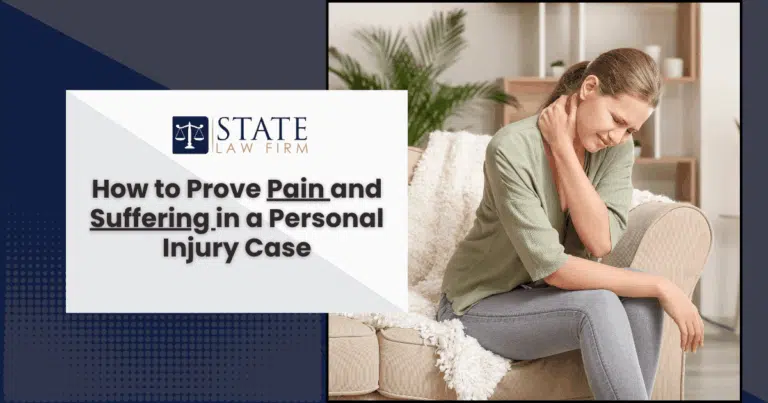When you’ve been injured in an accident, the consequences often extend far beyond the physical. Pain and suffering—both emotional and physical—can dramatically affect your daily life, relationships, and long-term wellbeing. Yet proving these non-economic damages in a legal setting can be one of the most challenging aspects of a personal injury claim.
According to a report from the Insurance Research Council, claimants represented by attorneys received settlements that were 3.5 times higher, on average, than those without legal representation (IRC Study). This underscores the value of working with an experienced personal injury firm that understands how to effectively present evidence of pain and suffering.
At State Law Firm, our boutique team of young, driven attorneys is committed to evolving as trial lawyers—taking on tougher cases and fighting for the full compensation our clients deserve. Whether you’re dealing with emotional trauma, chronic pain, or the daily toll of living with an injury, this guide will walk you through everything you need to know about proving pain and suffering in your case.
Let’s break it down.
Understanding Pain and Suffering in Personal Injury Law
Pain and suffering encompass the physical pain and emotional distress that follow a personal injury. While economic damages like medical bills or lost wages are easier to calculate, non-economic damages such as pain and suffering are deeply personal and often more difficult to prove.
These damages generally fall into two categories:
- Physical pain and suffering: Ongoing discomfort, chronic pain, or limitations in mobility that result from an injury.
- Emotional distress: Anxiety, depression, trauma, loss of sleep, or reduced quality of life stemming from the injury.
In California, the law recognizes that not all injuries leave visible scars. The emotional toll of an accident can be just as debilitating as the physical harm, and both deserve fair compensation.
Pro tip: Start keeping a recovery journal. Daily notes about your physical limitations, mental state, missed activities, and sleep disturbances can become powerful evidence later on.
The Importance of Documenting Your Injuries and Their Impact
Documentation can make or break a pain and suffering claim. Since non-economic damages are harder to quantify, thorough records that track your recovery are essential.
Make sure to:
- Keep copies of all medical records, including ER visits, follow-up care, and prescriptions.
- Collect written evaluations from physical therapists, psychologists, and physicians.
- Track missed workdays or lost income due to the injury.
- Maintain photos of your injuries over time.
- Note any hobbies or lifestyle changes you’ve had to give up.
Insurance adjusters and defense attorneys often try to downplay non-visible injuries. A well-documented case helps push back against those tactics and builds credibility.
Types of Evidence to Support Your Pain and Suffering Claim
Courts and insurance companies need objective proof to support subjective claims. Here’s the evidence that tends to carry the most weight:
- Medical expert reports: Detailed descriptions of your condition, pain levels, and long-term prognosis.
- Psychological evaluations: Assessments from therapists or counselors to establish trauma, anxiety, or depression.
- Accident reports: These can link the defendant’s actions directly to your injuries.
- Witness statements: Family, friends, or coworkers can provide insight into how your behavior, mood, or abilities have changed.
Pro tip: Ask your treating providers for summaries that clearly explain your condition in plain language. A jury won’t always follow dense medical jargon — clarity is key.
How to Calculate Pain and Suffering Damages: Methods and Formulas
There’s no exact science, but two common methods are used to estimate pain and suffering compensation:
- The Multiplier Method: This involves multiplying your total economic damages (e.g., medical expenses, lost wages) by a number between 1.5 and 5. The multiplier depends on the severity and impact of your injuries.
- The Per Diem Method: This assigns a daily dollar amount for your suffering, then multiplies it by the number of days you’ve endured the pain.
For example, if you’ve suffered from anxiety and chronic back pain for six months, a per diem rate of $150 could amount to $27,000 in non-economic damages.
Keep in mind:
- Severity of injuries
- Duration of recovery
- Level of interference with daily life
- Whether the condition is permanent
Pro tip: Don’t let the insurance company dictate the value of your suffering. A qualified attorney can advocate for a number that truly reflects what you’ve endured.
The Role of Attorneys in Proving Pain and Suffering Claims
Non-economic damages are often where a skilled attorney makes the biggest impact. At State Law Firm, we work closely with clients to turn their experience into compelling legal claims backed by credible evidence.
Here’s how we help:
- Gather and present expert medical testimony
- Highlight lifestyle disruptions in a humanizing and relatable way
- Address anticipated defenses and push back against minimization
- Negotiate directly with insurers to reach fair settlements
- Prepare for trial, when necessary, to demonstrate the full impact of your injury
We’re not just paper-pushers — we’re dedicated advocates with the energy and drive to take on more complex cases and fight for the full value of your pain and suffering.
Common Challenges When Proving Pain and Suffering in Court
Defense attorneys and insurers often cast doubt on pain and suffering claims. You may encounter:
- Accusations of exaggeration or fabrication
- Claims that the emotional distress is unrelated to the injury
- Arguments about pre-existing conditions
- Criticism of gaps or inconsistencies in treatment
Successfully overcoming these challenges requires a proactive approach. Consistent documentation, credible expert opinions, and a strong narrative that aligns your evidence with your experience all play a critical role.
Pro tip: Consistency builds credibility. Keep up with treatment and follow medical advice — skipping appointments or failing to report symptoms can weaken your claim.
Whether you’re just beginning your recovery or you’re already deep in the claims process, knowing how to properly prove pain and suffering could make the difference in your case. If you’re looking for legal partners who will take the time to understand your story — and fight to make sure it’s heard — you’re in the right place. We’re here to help.


